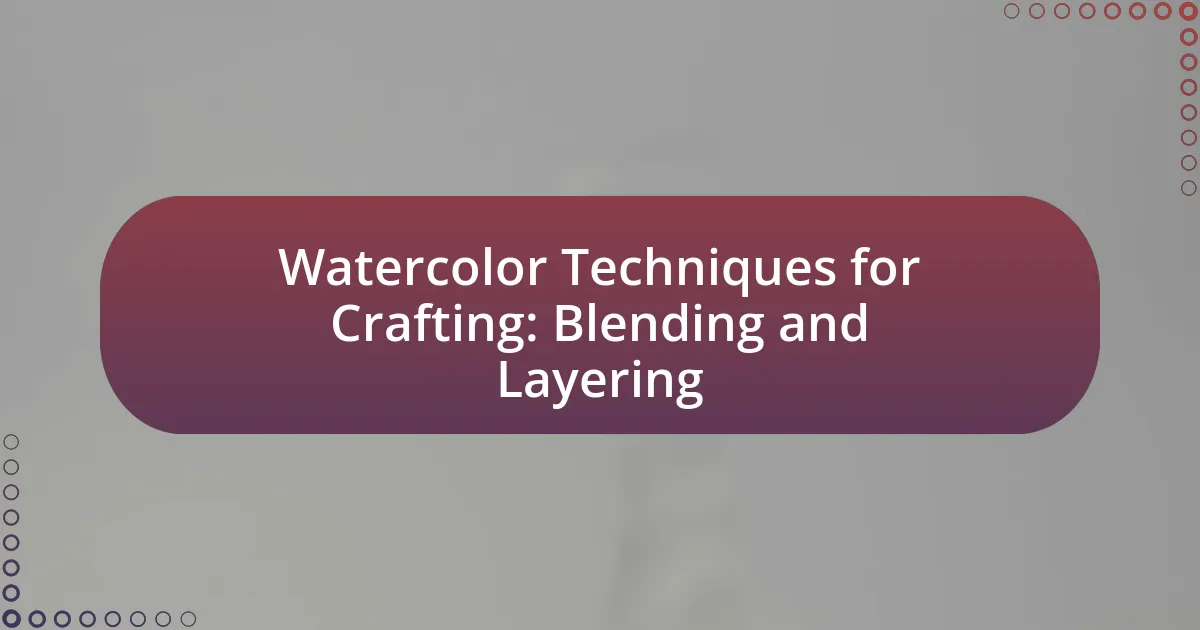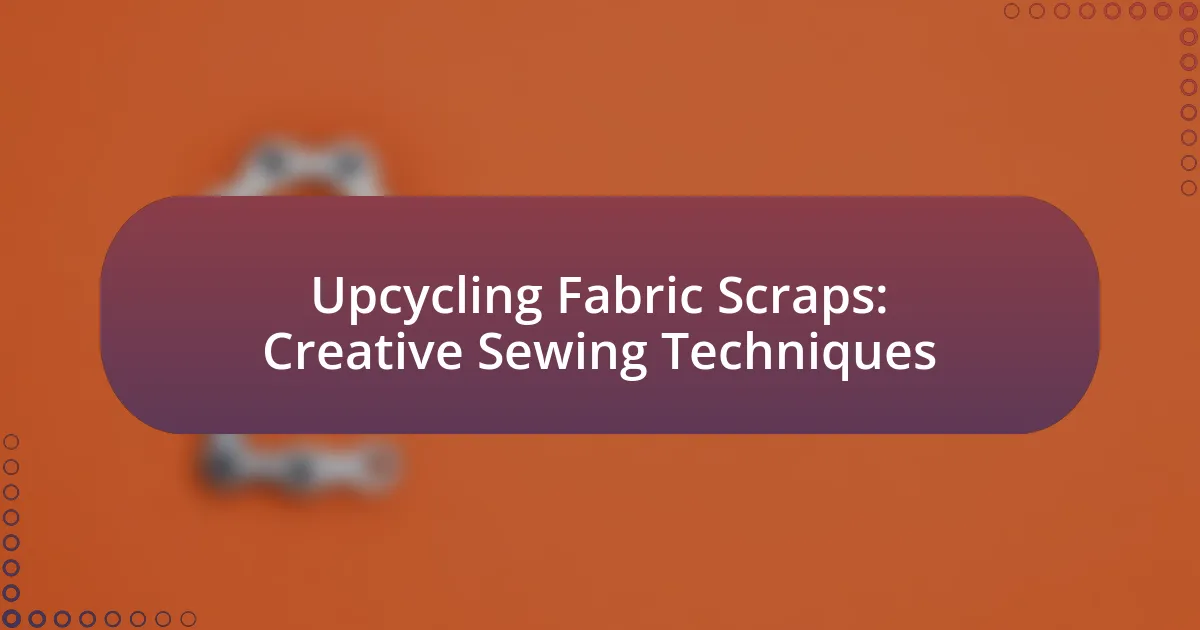Woodburning, or pyrography, is the technique of decorating wood by burning designs into its surface, utilizing a heated tool known as a pyrography pen. This article explores the significance of woodburning, detailing its historical context, essential tools, and the types of wood best suited for the craft. It covers various techniques, including shading, line work, and stippling, while emphasizing safety precautions and best practices for effective design transfer. Additionally, the article highlights popular themes and cultural motifs in woodburning, offers tips for mastering techniques, and addresses common mistakes and troubleshooting methods to enhance the woodburning experience.

What is Woodburning and Why is it Important?
Woodburning, also known as pyrography, is the art of decorating wood by burning designs into its surface using a heated tool. This technique is important because it allows for the creation of intricate and personalized designs, enhancing the aesthetic value of wooden items and promoting craftsmanship. Historically, woodburning has been practiced for centuries across various cultures, serving both decorative and functional purposes, such as in the creation of art pieces, furniture, and household items. The significance of woodburning lies in its ability to transform simple wood into unique, artistic expressions, fostering creativity and preserving traditional crafting techniques.
How does Woodburning work?
Woodburning works by using a heated tool to burn designs into wood surfaces. The tool, often called a pyrography pen, generates heat that causes the wood fibers to char, creating a permanent mark. The temperature and pressure applied by the tool determine the darkness and depth of the burn, allowing for a range of effects from light shading to deep grooves. This technique has been used historically for decorative purposes, with evidence of woodburning artifacts dating back to ancient civilizations, showcasing its long-standing application in art and craftsmanship.
What tools are essential for Woodburning?
The essential tools for woodburning include a woodburning pen or pyrography tool, various tips for different designs, a heat-resistant surface, and safety equipment such as gloves and goggles. The woodburning pen allows for precise control over the burning process, while interchangeable tips enable artists to create diverse textures and patterns. A heat-resistant surface protects the work area from damage during the burning process. Safety equipment is crucial to prevent burns and eye injuries, ensuring a safe working environment.
What types of wood are best for Woodburning?
The best types of wood for woodburning are hardwoods such as maple, birch, and oak. Hardwoods are preferred because they burn slowly and evenly, allowing for better control during the woodburning process. For instance, maple produces a fine grain that enhances detail, while birch has a smooth surface that is ideal for intricate designs. Oak, known for its durability, provides a consistent burn and rich color, making it a favorite among woodburning artists. These characteristics make hardwoods superior choices for achieving high-quality results in woodburning projects.
What are the different techniques used in Woodburning?
The different techniques used in woodburning include shading, line work, and stippling. Shading involves varying the pressure and speed of the woodburning tool to create gradients and depth, enhancing the three-dimensional appearance of the design. Line work focuses on creating detailed outlines and intricate patterns, often using fine tips for precision. Stippling consists of making small dots or dashes to add texture and detail, allowing for a unique visual effect. Each technique contributes to the overall aesthetic and complexity of woodburning projects, enabling artists to achieve diverse and personalized designs.
How do shading techniques enhance Woodburning designs?
Shading techniques enhance woodburning designs by adding depth and dimension, which creates a more realistic and visually appealing effect. These techniques, such as hatching, stippling, and blending, allow artists to manipulate light and shadow, making elements of the design stand out or recede. For instance, using varying pressure and speed with the woodburning tool can produce different shades, effectively simulating textures like fur or fabric. This approach not only enriches the aesthetic quality of the artwork but also engages viewers by drawing their attention to specific areas, thereby enhancing the overall impact of the woodburning piece.
What is the significance of line work in Woodburning?
Line work in woodburning is significant because it defines shapes, creates depth, and enhances the overall aesthetic of the artwork. The precision of line work allows artists to convey intricate details and textures, which are essential for achieving realism and visual interest in their designs. For instance, varying line thickness can suggest light and shadow, contributing to a three-dimensional effect. This technique is foundational in woodburning, as it establishes the framework upon which additional elements, such as shading and color, can be built.
What safety precautions should be taken during Woodburning?
During woodburning, essential safety precautions include wearing protective eyewear, using a heat-resistant surface, and ensuring proper ventilation. Protective eyewear prevents eye injuries from flying debris or sparks, while a heat-resistant surface minimizes the risk of fire hazards. Adequate ventilation is crucial to avoid inhaling harmful fumes released during the burning process. Additionally, keeping a fire extinguisher nearby and ensuring that the workspace is free of flammable materials further enhances safety. These precautions are supported by safety guidelines from organizations such as the Occupational Safety and Health Administration (OSHA), which emphasize the importance of personal protective equipment and safe work environments.
How can one prevent accidents while Woodburning?
To prevent accidents while woodburning, one should always use protective gear, including safety goggles, gloves, and a mask to avoid inhaling fumes. Additionally, maintaining a clean workspace free of flammable materials significantly reduces the risk of fire hazards. Proper ventilation is essential to disperse smoke and fumes, ensuring a safer environment. Furthermore, using tools designed for woodburning, such as a quality pyrography pen with a stable stand, minimizes the chance of burns or accidental contact with hot surfaces. Following these safety measures is crucial, as statistics indicate that improper handling of tools and materials accounts for a significant percentage of woodburning-related accidents.
What protective gear is recommended for Woodburning?
Protective gear recommended for woodburning includes safety goggles, a dust mask, heat-resistant gloves, and an apron. Safety goggles protect the eyes from smoke and debris, while a dust mask prevents inhalation of harmful particles. Heat-resistant gloves safeguard hands from burns, and an apron protects clothing and skin from hot materials. These items are essential for ensuring safety during the woodburning process, as they mitigate risks associated with heat, smoke, and particulate exposure.

What are the Unique Design Possibilities in Woodburning?
Unique design possibilities in woodburning include intricate patterns, detailed images, and personalized text. Artists can create a variety of effects by manipulating temperature and pressure, allowing for shading, line work, and texture. Techniques such as pyrography enable the rendering of realistic portraits or landscapes, while geometric designs can be achieved through precise tool control. The versatility of wood as a medium allows for experimentation with different types of wood, each providing unique grain patterns that enhance the final artwork.
How can one create intricate patterns in Woodburning?
To create intricate patterns in woodburning, one should utilize a combination of precise tools, techniques, and design planning. Using a woodburning pen with adjustable temperature settings allows for varying line thickness and shading, which is essential for detailed work. Additionally, sketching the desired pattern on paper before transferring it to the wood surface helps in maintaining accuracy and complexity in the design.
Employing techniques such as stippling, shading, and cross-hatching enhances the intricacy of the patterns. For instance, stippling involves creating texture through small dots, while shading can be achieved by varying the pressure and speed of the pen.
Research indicates that artists who practice these methods can achieve a higher level of detail and complexity in their woodburning projects, as evidenced by the diverse range of designs produced in workshops and tutorials focused on advanced woodburning techniques.
What are the best practices for transferring designs onto wood?
The best practices for transferring designs onto wood include using carbon paper, tracing methods, or laser printing. Carbon paper allows for easy transfer by placing it between the design and the wood, enabling the design to be traced with a pencil or pen. Tracing methods involve placing a printed design on the wood and using a stylus to outline it, ensuring accuracy. Laser printing directly onto the wood surface can produce high-quality results, especially when using a suitable wood type that can accept ink. These methods are validated by their widespread use among woodworkers and artists, ensuring precise and clear design transfers.
How does layering affect the complexity of designs?
Layering increases the complexity of designs by allowing for the creation of depth, texture, and intricate patterns. In woodburning, for instance, multiple layers of shading and detailing can transform a simple image into a rich, multi-dimensional artwork. This technique enables artists to blend various tones and contrasts, enhancing visual interest and sophistication. Research indicates that layered designs can evoke stronger emotional responses and engage viewers more effectively, as seen in studies on visual perception and art appreciation.
What themes are popular in Woodburning designs?
Popular themes in woodburning designs include nature, animals, mandalas, and geometric patterns. Nature themes often feature landscapes, trees, and floral designs, reflecting the beauty of the outdoors. Animal motifs are prevalent, showcasing various species and their intricate details. Mandalas provide a spiritual and meditative aspect, while geometric patterns offer a modern aesthetic. These themes are favored for their versatility and ability to resonate with a wide audience, making them staples in woodburning artistry.
How can nature inspire Woodburning artwork?
Nature can inspire woodburning artwork by providing a diverse range of themes, patterns, and textures that artists can replicate. For instance, the intricate details of leaves, the fluidity of water, and the ruggedness of tree bark can all serve as direct references for designs. Artists often observe natural landscapes, flora, and fauna to capture their essence in woodburning, translating organic forms into unique artistic expressions. This approach is validated by the prevalence of nature-themed art throughout history, where artists like John James Audubon have famously depicted wildlife, influencing contemporary woodburning techniques that emphasize realism and detail.
What cultural motifs can be incorporated into Woodburning?
Cultural motifs that can be incorporated into woodburning include Celtic knots, Native American symbols, Japanese cherry blossoms, and African tribal patterns. These motifs are significant in their respective cultures; for instance, Celtic knots represent eternity and interconnectedness, while Native American symbols often convey spiritual meanings and connections to nature. Japanese cherry blossoms symbolize the transient nature of life, and African tribal patterns reflect community and heritage. Each motif can enhance the aesthetic and cultural depth of woodburning projects, making them not only visually appealing but also rich in meaning.

How to Master Woodburning Techniques for Unique Designs?
To master woodburning techniques for unique designs, one must practice various methods such as shading, line work, and texturing using a woodburning tool. Mastery involves understanding the temperature settings of the tool, as different temperatures create distinct effects on wood surfaces. For instance, lower temperatures produce lighter burns suitable for delicate details, while higher temperatures yield darker, more pronounced lines. Additionally, experimenting with different types of wood can enhance the uniqueness of designs, as each wood type reacts differently to heat. Regular practice and studying the works of experienced woodburning artists can further refine skills and inspire creativity.
What are the steps to improve your Woodburning skills?
To improve your woodburning skills, practice consistently, study techniques, and seek feedback. Consistent practice allows you to refine your control over the tool and develop your artistic style. Studying techniques, such as shading, line work, and texture creation, enhances your understanding of the medium. Seeking feedback from experienced woodburners or joining a community can provide valuable insights and constructive criticism, which are essential for growth.
How can practice sessions be structured for better results?
Practice sessions can be structured for better results by incorporating focused goals, varied techniques, and consistent feedback. Setting specific objectives for each session, such as mastering a particular woodburning technique or design, enhances concentration and progress. Additionally, alternating between different styles or methods during practice can improve versatility and skill retention. Regularly seeking feedback from peers or instructors allows for the identification of areas needing improvement, which is crucial for skill development. Research indicates that deliberate practice, characterized by these elements, significantly enhances performance in artistic disciplines, including woodburning.
What resources are available for learning advanced Woodburning techniques?
Online platforms such as Skillshare and Udemy offer comprehensive courses on advanced woodburning techniques, featuring expert instructors and structured lessons. Additionally, books like “The Art of Woodburning” by John D. McDonald provide in-depth insights and step-by-step guides for mastering complex designs. Furthermore, YouTube channels dedicated to pyrography showcase tutorials that cover advanced methods and tips from experienced woodburners, allowing learners to visually grasp intricate techniques. These resources collectively enhance the learning experience for those seeking to refine their woodburning skills.
What common mistakes should be avoided in Woodburning?
Common mistakes to avoid in woodburning include using the wrong temperature, which can lead to uneven burns or damage to the wood. Additionally, not practicing on scrap wood can result in poor technique and unsatisfactory designs. Failing to maintain a steady hand can cause wobbly lines and inconsistent shading. Lastly, neglecting to plan the design beforehand can lead to mistakes that are difficult to correct. These errors can significantly impact the quality of the final piece, making it essential for woodburners to be mindful of these common pitfalls.
How can one troubleshoot issues with Woodburning designs?
To troubleshoot issues with woodburning designs, one should first identify the specific problem, such as uneven burning, smoke production, or tool malfunction. For uneven burning, ensure the wood surface is clean and smooth, and adjust the temperature of the woodburning tool to achieve consistent results. If excessive smoke is produced, check the type of wood being used; hardwoods typically produce less smoke than softwoods. Additionally, ensure the tip of the woodburning tool is clean and free from residue, as this can affect performance. Regular maintenance of the tool, including replacing worn tips, can also prevent issues. These troubleshooting steps are supported by common practices among woodburning artists, emphasizing the importance of proper technique and equipment care.
What are the signs of improper technique in Woodburning?
Signs of improper technique in woodburning include inconsistent line thickness, excessive smoke or charring, and uneven shading. Inconsistent line thickness indicates a lack of control over the tool, which can result in a disjointed appearance. Excessive smoke or charring suggests that the burner is set to too high a temperature or that the tool is held too long in one spot, leading to damage to the wood. Uneven shading occurs when the artist fails to apply consistent pressure or speed, resulting in patches that are either too light or too dark. These signs can detract from the overall quality of the woodburning project and indicate a need for improved technique.
What tips can enhance your Woodburning experience?
To enhance your woodburning experience, use high-quality tools and materials. Quality woodburning pens, such as those with adjustable temperature settings, allow for greater control over the burning process, resulting in more precise designs. Additionally, selecting the right type of wood, like basswood or birch, can significantly affect the outcome, as these woods burn evenly and showcase details well. Properly preparing the wood surface by sanding it smooth ensures better adherence of the burn marks, leading to cleaner lines and more defined patterns. Furthermore, practicing different techniques, such as shading and texturing, can expand your skill set and improve the overall quality of your work.




